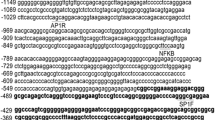Abstract
NKX3.1 is a prostate-specific homeobox gene related strongly to prostate development and prostate cancer. However, little is known about the mechanism for regulation of NKX3.1 in prostate cancer. With RT-PCR and western blot, we found that NKX3.1 expression was enhanced by over-expression of Sp1 at both the mRNA and protein levels in prostate cancer LNCaP cells. To identify the Sp1-elements in the promoter region of NKX3.1, a 521 bp-promoter of human NKX3.1 gene containing three possible Sp1-elements was cloned into the upstream of the luciferase reporter gene in pGL3-basic plasmid. With deletion mutation analysis, plasmid construction, EMSA and oligonucleotide decoy technique, two Sp1-elements which located between +29 to +43 and −60 to −46 of NKX3.1 gene were identified and proven to be functional elements. It will be important to further study on the functions and the regulatory mechanisms of Sp1 element in NKX3.1 gene expression.






Similar content being viewed by others
References
He WW, Sciavolino PJ, Wing J et al (1997) A novel human prostate-specific, androgen-regulated homeobox gene (NKX3.1) that maps to 8p21, a region frequently deletion in prostate cancer. Genomics 43:69–77
Voeller HJ, Augustus M, Madike V et al (1997) Coding region of NKX3.1, a prostate-specific homeobox gene on 8p21, is not mutated in human prostate cancers. Cancer Res 57:4455–4459
Bergerheim US, Kunimi K, Collins VP et al (1991) Deletion mapping of chromosomes 8, 10, and 16 in human prostatic carcinoma. Genes Chromosom Cancer 3:215–220
Vocke CD, Pozzatti RO, Bostwick DG et al (1996) Analysis of 99 microdissected prostate carcinomas reveals a high frequency of allelic loss on chromosome 8p12-21. Cancer Res 56:2411–2416
Bova GS, Carter BS, Bussemakers MJ et al (1993) Homozygous deletion and frequent allelic loss of chromosome 8p22 loci in human prostate cancer. Cancer Res 53:3869–3873
Trapman J, Sleddens HF, van der Weiden MM et al (1994) Loss of heterozygosity of chromosome 8 microsatellite loci implicates a candidate tumor suppressor gene between the loci D8S87 and D8S133 in human prostate cancer. Cancer Res 54:6061–6064
Cher ML, Bova GS, Moore DH et al (1996) Genetic alterations in untreated metastases and androgen-independent prostate cancer detected by comparative genomic hybridization and allelotyping. Cancer Res 56:3091–3102
Dong JT (2001) Chromosomal deletions and tumor suppressor genes in prostate cancer. Cancer Metastasis Rev 20:173–193
Bowen C, Bubendorf L, Voeller HJ et al (2000) Loss of NKX3.1 expression in human prostate cancers correlates with tumor progression. Cancer Res 60:6111–6115
Ornstein DK, Cinquanta M, Weiler S et al (2001) Expression studies and mutational analysis of the androgen regulated homeobox gene NKX3.1 in benign and malignant prostate epithelium. J Urol 165:1329–1334
Jiang AL, Yu CX, Zhang PJ et al (2006) P53 overexpression represses androgen-mediated induction of NKX3.1 in a prostate cancer cell line. Exp Mol Med 38:625–633
Yu CX, Liu WW, Wu WF et al (2007) Overexpression of p53 inhibits promoter activity of NKX3.1 gene. Chin J Biochem Mol Biol 23:560–565
Thomas K, Wu J, Sung DY et al (2007) Sp1 transcription factors in male germ cell development and differentiation. Mol Cell Endocrinol 270:1–7
Morishita R, Higaki J, Tomita N et al (1998) Application of transcription factor “decoy” strategy as means of gene therapy and study of gene expression in cardiovascular disease. Circ Res 82:1023–1028
Cho-Chung YS, Park YG, Lee YN (1999) Oligonucleotides as transcription factor decoys. Curr Opin Mol Ther 11:386–392
Mann MJ, Dzau VJ (2000) Therapeutic applications of transcription factor decoy oligonucleotides. J Clin Invest 106:1071–1075
Tomita S, Tomita N, Yamada T et al (1999) Transcription factor decoy to study the molecular mechanism of negative regulation of renin gene expression in the liver in vivo. Circ Res 84:1059–1066
Jiang AL, Zhang JY, Young C et al (2004) Molecular cloning and characterization of human homeobox gene NKX3.1 promoter. Acta Biochim Biophys Sin 36:64–67
Ibanez-Tallon I, Ferrai C, Longobardi E et al (2002) Binding of Sp1 to the proximal promoter links constitutive expression of the human uPA gene and invasive potential of PC3 cells. Blood 100:3325–3332
Faber PW, Van Rooij HC, Schipper HJ et al (1993) Two different, overlapping pathways of transcription initiation are active on the TATA-less human androgen receptor promoter. The role of Sp1. J Biol Chem 268:9296–9301
Takane KK, Mcphaul MJ (1996) Functional analysis of the human androgen receptor promoter. Mol Cell Endocrinol 119:83–93
Acknowledgments
The authors are grateful to Dr. Tan-Jun Tong at Beijing University in China for kindly providing the pCMV-Sp1 plasmid used in this study. This work was supported by Natural science Foundation of Shandong province (No.Y2005C10, No.Y2005C03 and No.Y2007C96); National Natural science Foundation of China (No.30670581, No.30470952 and No.30870732)
Author information
Authors and Affiliations
Corresponding authors
Additional information
Chun-xiao Yu and Tong Jin contributed equally to this work.
Rights and permissions
About this article
Cite this article
Yu, Cx., Jin, T., Chen, Ww. et al. Identification of Sp1-elements in the promoter region of human homeobox gene NKX3.1 . Mol Biol Rep 36, 2353–2360 (2009). https://doi.org/10.1007/s11033-009-9457-y
Received:
Accepted:
Published:
Issue Date:
DOI: https://doi.org/10.1007/s11033-009-9457-y




